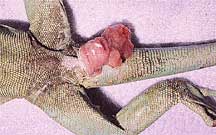Difference between revisions of "Lizard Cloacal Prolapse"
Jump to navigation
Jump to search
| Line 1: | Line 1: | ||
| − | {{ | + | {{review}} |
[[Image: Cloacal_prolapse_lizard.jpg|300px|thumb|right|'''Cloacal prolapse''' (Copyright © RVC and its licensors, Sean Bobbit, Sue Evans, Andrew Devare and Claire Moore. All rights reserved)]] | [[Image: Cloacal_prolapse_lizard.jpg|300px|thumb|right|'''Cloacal prolapse''' (Copyright © RVC and its licensors, Sean Bobbit, Sue Evans, Andrew Devare and Claire Moore. All rights reserved)]] | ||
Revision as of 17:51, 2 April 2010
| This article has been peer reviewed but is awaiting expert review. If you would like to help with this, please see more information about expert reviewing. |
Cloacal prolapse is a common problem in lizards; it is usually secondary to an infective process or straining due to dystocia or constipation.
The clinical signs in a male lizard are usually one or both of the hemipenes prolapsed; in females, they usually include a partial prolapse of the oviduct, if complete usually severely traumatised.
- Diagnosis - History, physical examination, microscopy, culture and sensitivity.
- Treatment depends on the severity of the case:
- Mildly traumatised cases:
- Gently cleanse exposed tissues
- Apply local antibiotics
- Lubricate and replace
- Severely traumatised cases:
- Amputation under general anaesthesia
Amputation of hemipene: Place one or more mattress sutures through viable tissue proximal to proposed point of amputation. After excision allow ligated stump to retract into hemipenal pockets. Parenteral antibiotics are advised.
Amputation of oviduct: ovariosalpingectomy (see Lizard and Snake Dystocia)
